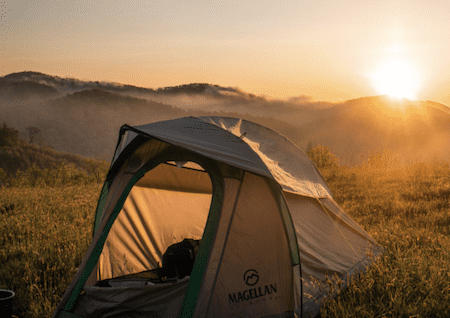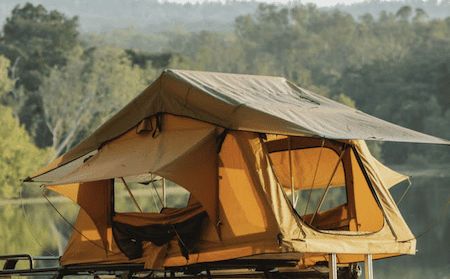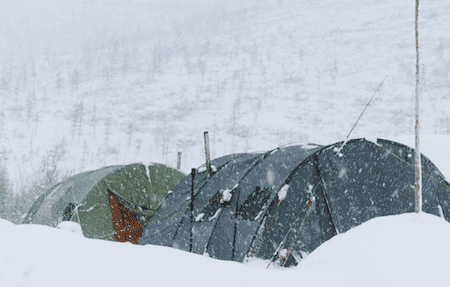Camping in the wilderness can be a fun, refreshing, and rewarding experience.
But it doesn’t take much to ruin an enjoyable camping trip. And facing a situation that leaves you with a wet tent can be one of the most uncomfortable mishaps during your stay.
Having a wet tent can quickly ruin your camping trip. If you are planning a camping trip, it’s always best to face any adverse situation.
Knowing how to keep your tent dry inside can always come in handy.
This article has noted down some of the best tips and tricks to keep your tent dry throughout your camping adventure.
How To Keep Your Tent Dry Inside
One of the most typical camping hazards is getting a damp tent. Cleaning or drying a wet tent can be a pain.
But, as difficult as it may appear, all it needs is a little forethought and a few extra supplies to keep your tent dry all night.
Here are some simple, quick, and easy techniques to keep the inside of your tent dry at all times.
#1. Find The Right Spot
The most crucial step is to set up your camping tent in the proper location.
Pitch your tent high on a ridge where water will likely drain off. Condensation may be reduced by pitching your tent further away from water sources.
If you must camp near a water source, set up your tent at a slight slant so that the water flows instead of collecting beneath you.
In deciding where to camp, you should look for a place that is in a clearing. Staying beneath cover may be a smart option, but this is not the case.
Rain will fall from the trees on you long after it has begun to rain. Plus, you won’t be safe under the trees if it’s still thundering and there’s lightning.
If at all possible, stay away from long grass. Long grass catches moisture and dumps it high on your tent’s walls.
When camping in tall grass, you also tend to walk more damply into your porch and your tent.
#2. Create A Transition Zone
To learn how to keep your tent dry inside, you must know how to create a transition zone.
A transition zone is a dry area between the outside and the tent inside.
This buffer zone between the outside and inside of your tent will help keep moisture out.
Before settling into your tent, make sure you have a place to remove your shoes, jacket, and other gear.
This step is essential if the weather outside has been damp or rainy.
Some tents have a big awning or a screened-in vestibule specifically.
You’ll need to improvise with tarps and rope or a tiny canopy supported by poles.
#3. Have A Quality Sleep Set Up
When camping, it’s crucial to have items that will keep you as dry as possible when sleeping.
You may not realize that little droplets of vapor are released into the air when you breathe.
This mist has the potential to create condensation. It gets inside the tent, and moisture will build up within the tent over the night if it’s entirely closed.
This is why a good sleep setup is essential for a dry tent. Keeping a tent dry also means protecting oneself from becoming wet.
There are a few things to consider while selecting sleeping clothing for the driest tent.
When down sleeping bags get wet, they become utterly unusable. Instead, choose bags made of synthetic fabrics for optimal warmth and dryness.
Elevating oneself keeps you drier as well. The earth maintains moisture even if the sky is clear on your camping excursion.
This moisture will collect on everything near the ground. As a result, you might consider airbeds or cots to keep your sleeping bags away from the ground’s moisture.
#4. Ensure Ventilation
The most efficient technique to minimize condensation is to ventilate your tent and promote optimum airflow to reduce interior humidity.
Tents with adequate ventilation and an inner tent will fare well in heavy condensation situations.
However, any tent’s design might be overrun by moisture in certain weather circumstances.
This is why additional means of ventilation are essential. Humans, heaters, and poor ventilation can cause the tent to grow warm and humid.
Look for low and high venting options in your tent and open them to allow the damp air to escape.
Leave the upper and bottom portions of the door open if the weather permits; the mesh sections can be entirely zipped.
If necessary, ensure the tent’s back vents are entirely open.
Lastly, make sure that no bags or sleeping people block the vents.
#5. Build A Campfire
It might seem unusual, but a campfire can also be a good option to keep your tent dry.
The warmth will dry out your tent from a distance of several meters.
But, you need to know that the fire could be dangerous if it’s too close to the tent.
It’ll create sparks that’ll cut holes in the tent. So, keep an eye out for the sparks to save your tent.
#6. Use A Water Repellant
Another alternative for keeping out the rain and keeping your tent as dry as possible is waterproofing your tent or using a water repellant.
There are several sprays on the market. The water-repellant is sprayed on the tent’s outside to ensure it’s adequately protected.
It will help improve the tent’s waterproof quality, which will make you feel a lot better and allow the rain to roll off the exterior of your tent as it does on a raincoat.
That will keep your tent warm and dry on the inside as well.
If you’re going camping and expect rain, it’s usually a good idea to test the waterproofing on your tents before you leave.
#7. Keep Some Activities For The Outdoors
When you’re worried about dampness inside your tent, some chores and activities are better done outside.
Cooking, heating, storing damp items, and other similar activities should be avoided inside.
There are several reasons not to cook in your tent, ranging from safety to excessive condensation.
Cooking releases a lot of moisture into the atmosphere. This is why it’s better to cook food and boil water outside, where vapors can escape, rather than inside your tent, which may considerably raise the humidity levels.
It’s also not good to use a heater inside your tent if you want to keep it dry.
Warm air may hold more moisture, and the warmer the tent, the more humidity will be absorbed through evaporation and perspiration.
Warm yourself instead of the tent by wearing comfortable clothing and napping in quality sleeping bags.
#8. Use A Groundsheet
A groundsheet, often known as a ground cloth or even a ground fly, is a waterproof piece of material that covers your tent’s footprint.
A well-placed tarp or a tight-fitting groundsheet will keep moisture from your tent and protect it from harm.
The groundsheet is placed on the ground first, followed by your tent.
The ground fly should be constructed of waterproof material and smaller than the bottom of your tent to prevent water from entering the tent from the sides.
Even if you don’t anticipate rain, it’s smart to use the groundsheet because there is moisture in the ground that your tent can absorb.
If you don’t have a groundsheet, consider covering your tent with an old tarp that is wider than your tent’s footprint.
They keep your tent dry on the inside, but they also increase its resilience, thereby extending its lifespan. It will also function as an additional wind and rain barrier, keeping you dry.
And if you’re in the market for a new tent, make sure it has a bathtub bottom.
The floor’s substance extends not only to the ground, but also to the sidewalls, forming a barrier against water infiltration.
A good 3 to 6-inch bathtub floor all around your tent is ideal.
That fabric usually is thicker than the rest of the tent, which is encouraged since the thicker it is, the more waterproof it will be.
#9. Keep Ample Towels
Condensation might be difficult to avoid under certain weather conditions.
Avoid getting moisture inside your tent, but if somehow you do, be prepared to dry it out.
When it comes to drying your tent, nothing beats a micro-towel. Wiping the walls with a towel or cloth removes moisture and prevents leaks.
These are virtually weightless and may be tossed into your pack. They take up a lot of water and maybe wrung out several times to dry off your tent.
Additionally, install an awning, tarp, or hub to store wet gear.
If you’re a frequent camper, it is best to invest in good camping rain gear, a nice rain jacket, waterproof trousers, and a sturdy tent.
#10. Keep The Weather Conditions In Mind
Even if you know everything about how to keep your tent dry inside, you won’t have any control over the weather.
When the weather outside the tent is much colder than the weather, condensation can be exacerbated, especially after a hot, humid day.
It might be challenging to keep tent condensation from accumulating when the temperature drops significantly.
If there’s any wind, attempt to pitch your tent with the entrance facing away from it. Pitch your tent with the vents towards the prevailing winds.
Make sure your tent is secured with guylines, that the tension on all sides is equal, and that your guylines are strong.
It’s critical to keep yourself dry once you’ve worked out the best techniques to keep your tent dry.
That means remaining as much as possible inside the tent and dressing up properly.
Make sure your outer layers, if not all of your clothing, are waterproof.
Conclusion
Having a dry tent is an absolute must to get the most comfortable camping experience.
By securing your camping equipment, you will avoid replacing it every year.
Just find the right spot, keep an eye out for bad weather, and use everything we’ve discussed in this guide.
Now that you know how to keep your tent dry inside, you’ll have a more enjoyable trip.




